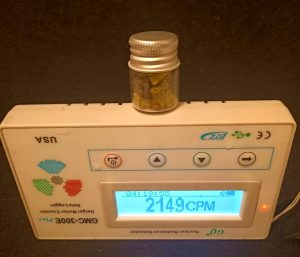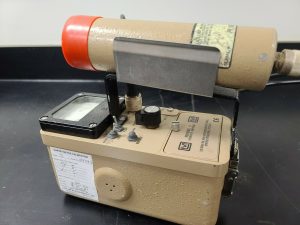"How Many CPM Should My Sample Read" :
Why There's No Easy Answer

It is natural to ask the following question when coming into a radioactivity hobby:
“How many CPM should (xyz sample) read on my Geiger counter?”
The answer can be impossible to answer and there are several, main reasons why.
1) Readings of Counts Per Minute (CPM) can differ greatly between two perfectly calibrated Geiger counters, due to huge sensitivity and efficiency factors accounting for as much as 18x more or fewer CPM between two of the probes owned by SciHobby authors!
2) There are quantitative sources intended for calibration, and qualitative sources meant as Geiger checks, collectibles, or for demonstrations.
3) Activity levels that should always be in agreement are expressed in Becquerels (Bq) or Curies (Ci). These cannot be measured with Geiger Counter.
Readings Differ Vastly Between Different Geiger Counters (Measuring the Same Sample)

Readings Differ Vastly Between Different Geiger Counters (Measuring the Same Sample)
CPM readings on your unit can be a fantastic source of information for many purposes. These counts, however, can read incredibly greater or fewer in number between various types of probes designed for different purposes. This often causes misunderstandings.
For one thing, different probes have different amounts of surface area receiving emissions per second. This is one of the first realizations we come to. How could a 4 square centimeter and a 16 square centimeter probe surface possibly yield the same information when one is catching more rays? Secondly, probes have windows or barriers radiation must cross. Window thickness and material type cause more or less radiation to make it inside the probe (this even effects various radiation types differently). Thirdly, depth and volume of the probe’s interior, along with how much anode is in there to read counts, and how it is arranged all come into play, as well.
When someone (with a pancake probe) sells a rock online and says it reads 30,000 CPM, it’s a pretty loaded statement that gets some unwitting buyers disappointed, using side window or even end window probes.
There Are Calibration Sources
Calibration sources are typically something like an expensive, little, sealed and labeled disc containing a certain isotope such as Cesium 137 or Cobalt 60. It is refined, reliable for a certain time frame, and meant to give the same reading from the same equipment every time, under the same conditions. A calibration source is a “quantitative source”. The only way it can be used for calibration is when, for example, literature is provided for a specific probe dictating the desired reading from an exact distance.
A common Geiger check source is more of a “qualitative source”, versus being a quantitative source. It’s not meant for calibration but can be used to show the unit is working, compare levels relative to other sources, and are useful for many types of demonstrations. We’ve seen someone sell uranium rocks for “poor boy” calibration, but it was just for ballpark hobby purposes, and you could only use exactly the same probe he used.
Counts vs. (Overall) Activity Levels
In the science world, Bq or Ci are used to express activity levels upon which physicists should always agree. You don’t see someone wave a wand at an isotope and quote it’s Bq because, for one thing, the genuine activity is being emitted in 360 degrees, whereas a probe is receiving a limited arc or amount of the source’s total emissions. Plus, as explained above, different styles of probes would also disagree, anyway.
Static activity levels expressed in Bq represent decays per second, emitted in all directions. This nomenclature is more a product of scientists working with math and the nuclear physics of precisely what’s going on with the decay that it is any type of unit measured 100% efficiently with any type of sensors.
Counts vs. Doses (Rads and Seiverts)
To further complicate readings between hardware, Geiger counters often display exposure dose-related nomenclature in rem, rads, or roentgen per hour (R/hr.) or Sieverts per hour (Sv/hr.). These are expressions of radiation energy (either being transmitted through the air or being received by an object) as opposed to mere counts that do not involve energy levels per count (which do vary greatly). The problem with many of these devices dealing with dose equivalents, though, is that Geiger counters don’t truly read energy levels per count. They are merely provided with some kind of, often, arbitrary conversion factor between CPM and dose like mrem/hr., mR/hr. or uSv/hr.
The reason this is a problem is 1000 CPM from one element can carry more or less energy than 1000 CPM from another element. This can easily mean that your reading in dose nomenclature from a Geiger counter is way off unless you know what isotope the unit’s conversion factor from CPM to mR/hr is meant for. This conversion factor yields around 20% different results between Cs137 and Co60. If you’re measuring one isotope when the unit’s conversion factor was meant for another, your R/hr or Sv/hr. will be pretty inaccurate.
One more issue is Geiger counters can’t tell the difference between alpha, beta, or gamma. This matters dealing with dose-related units because, while rads, rem, and R (roentgens) are generally equivalent for beta and gamma radiation, rems should theoretically become much higher than rads or R when dealing with alpha radiation because, here, you get into the nomenclature differences between exposure, absorbed dose, or dose equivalence all out of the scope of this article. More can be found the NRC and/or HPS.
If you like to pay attention to rads or Seiverts more than CPM, find out what isotope the conversion factor you unit is using was meant for. Some units are coming out where you can enter a multiplier or pick an isotope most similar, in this manner, to the type of specimen you’re reading. Otherwise, take dose readings from Geiger counters with a grain of salt, or maybe some potassium iodide.
